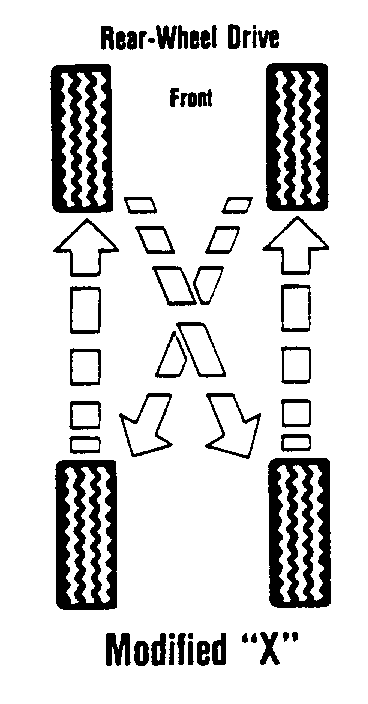REVISED WHEEL ALIGNMENT SPECIFICATIONS

WHEEL ALIGNMENT SPECIFICATIONS
VEHICLES AFFECTED: 1988 F-CAR -----------------
In order to address tire wear on 1987-88 F-cars, the front alignment specifications have been changed. The new alignment specifications at "Curb" trim are as follows:
Front TOTAL Toe 0 degrees +/- 0.2 degrees
Front Camber 0.3 degrees +/- 0.5 degrees
Front Caster 4.7 degrees +/- 0.5 degrees
Cross Camber (L-R) 0 degrees +/- 0.7 degrees
Cross Caster (L-R) 0 degrees +/- 0.7 degrees
- Vehicle must be jounced three times (down only) before checking alignment, to eliminate false geometry readings.
- Front toe adjustment (0 degrees plus or minus 0.1 degrees) to be set separately per wheel, with steering wheel held in "straight ahead" position within plus or minus 3.5 degrees.
TIRE ROTATION
IMPORTANT ON ALL VEHICLES - To further help minimize tire wear, stress the importance of regular tire rotation to the owner. The modified "X" pattern at 7,500 miles is recommended (See Illustration). Also, point out the importance of proper inflation pressure, as listed on the tire placard on the driver's door edge.
NOTICE: IF YOU HAVE P245/50VR16 TIRES ON YOUR FIREBIRD/CAMARO THE TIRES MUST BE DISMOUNTED FROM THEIR WHEELS BEFORE THEY CAN BE ROTATED. THIS IS BECAUSE YOUR FRONT AND REAR WHEEL HAVE DIFFERENT OFFSETS, AND YOUR TIRES ARE DIRECTIONAL.
DIRECTIONAL TIRES HAVE AN ARROW ON BOTH SIDES OF THE SIDEWALL POINTING IN THE DIRECTION THE TIRES MUST ROLL FOR THE PERFORMANCE. THERE IS NO "INSIDE" OR "OUTSIDE" TO THIS TIRE. WHEN TIRE ROTATION IS NEEDED, YOU SHOULD GO TO YOUR CAR DEALER OR QUALIFIED TIRE DEALER AND HAVE THEM FOLLOW THESE STEPS:
1. Dismount tires from the wheels.
2. Rotate the tires (not wheels) as shown in the rotation pattern illustration. Make sure the tires are rotating in the direction of the arrows.
3. Rebalance tires.
4. Replace wheels in their original position.

General Motors bulletins are intended for use by professional technicians, not a "do-it-yourselfer". They are written to inform those technicians of conditions that may occur on some vehicles, or to provide information that could assist in the proper service of a vehicle. Properly trained technicians have the equipment, tools, safety instructions and know-how to do a job properly and safely. If a condition is described, do not assume that the bulletin applies to your vehicle, or that your vehicle will have that condition. See a General Motors dealer servicing your brand of General Motors vehicle for information on whether your vehicle may benefit from the information.
